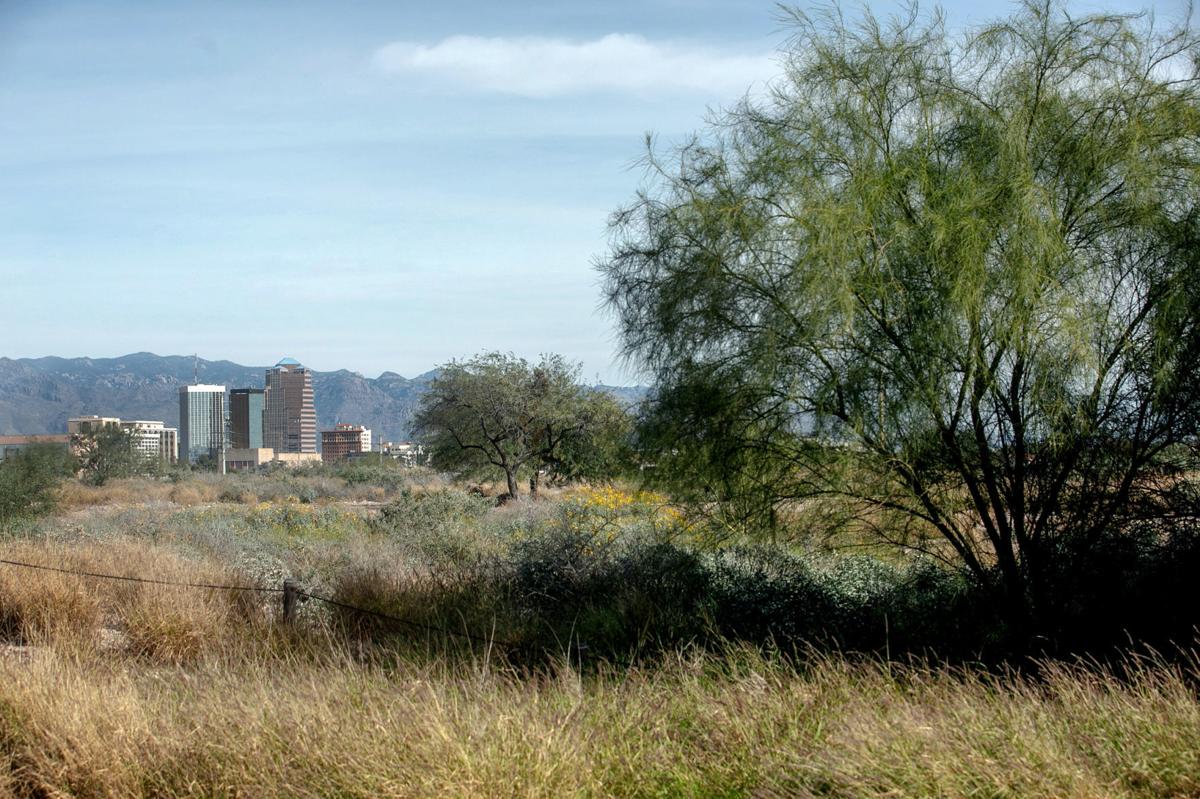More than 200,000 cubic yards of sediment will be removed from the Santa Cruz River and relocated to a landfill near “A” Mountain next year, temporarily halting the release of new effluents into the river and renewing discussions over whether to convert the site to a Sonoran desert park to honor Tucson’s birthplace.
The Pima County Board of Supervisors approved a no-cost contract with Rio Nuevo last week that covers the removal of material from a stretch of the river between West 29th and West Cushing streets, marking the fourth and final phase of a long-term effort to remove excess dirt and debris from the riverbed to abate potential flooding. The county also is on the hook for the regrading and hydroseeding of the sediment, and any damages to the landfill site.
The intergovernmental agreement passed 3-2, with no votes coming from Supervisors Richard Elias, a Democrat who represents District 5, and Ally Miller, a Republican who represents District 1. Miller said she voted against the contract because she doesn’t “think we should be doing this amount of work and not charging the Rio Nuevo tax district for it.”
The area at the base of “A” Mountain is widely recognized as Tucson’s birthplace, a site of human habitation for at least 10,000 years and of crop cultivation for at least 4,000 years. Right next to the landfill is the Mission Garden Project, a re-creation of the Spanish colonial walled garden that was part of Tucson’s historic San Agustin Mission. That’s billed as the first step toward creating what is named “Tucson Origins Heritage Park.”
While the contract between Rio Nuevo and Pima County does not specify what will happen at the landfill site, Katya Peterson, a co-chair of Friends of Tucson’s Birthplace, the group that created the garden, reiterated their efforts to create the heritage park following this week’s agreement.
“We’re excited that something is finally happening. We’re going to keep our fingers crossed for the future,” she said. “We’re very hopeful.”
Rio Nuevo chairman Fletcher McCusker cautioned that “nothing’s really changed for us” regarding the landfill site.
That stems from the fact that there are still lingering issues with the 27-acre plot, 25 of which previously served as the city’s dump. He estimated it would cost $35 million to “clean” the site of any potential environmental issues.
“I guess you can consider this some sort of progress. The big challenge for all of us is remediating the landfill,” said McCusker, who added that the dirt that is being moved could potentially be used to replace any toxic materials excavated from the landfill. “My hope is now that the various parties – the county, the city, Rio Nuevo – we’ve got to sit down and figure out that landfill.”
The Pima County Regional Flood District has been working to remove unwanted sediment from the riverbed since the county took over maintenance responsibility for the Santa Cruz River and other regional courses in 2014.
The sediment has reduced capacity in some stretches of the riverbed by two-thirds, meaning “the river is not performing as well as it’s designed,” said Eric Shepp, deputy director for the flood control district.
In the first two phases of the project, more than 200,000 cubic yards of material was removed at a cost near $1.8 million in the areas between West Speedway Boulevard and Grant Road, and relocated to an area north of Grant that was eroded during the 1983 flood.
The decision to instead move the sediment to the “A” Mountain site was a cost-saving measure as it is considered to be in a free haul distance from the river.
“The idea is we can save quite a bit of dollars on haul costs just by placing it on the A-Mountain landfill,” Shepp said, adding that the funding for all the projects comes the county’s flood control district tax levy.
The next phase is scheduled to begin in January, when approximately 169,000 cubic yards of material will be removed from West Grant to Prince roads over a two-month period.
The 29th-to-Cushing project is expected to take six weeks and remove 85,000 cubic yards of material starting in July. That project was initially estimated to cost $800,000, but they’ll be soliciting bids on it closer to the project date.
As part of the final phase, Tucson Water will temporarily halt the release of water from the Santa Cruz River Heritage Project. The city has been releasing reclaimed water into the river since June in order to restore some of the riparian habitat that disappeared after groundwater pumping dried up the river in the 1940s and ’50s.
Fernando Molina, a spokesman for Tucson Water, said they’ve been aware of the upcoming closure and have been working to see what “the end result will look like.”
“Their objective is to remove as much sediment as they need to, while we would like to maintain some of that,” he said. “We’re working really closely with them on this.”





